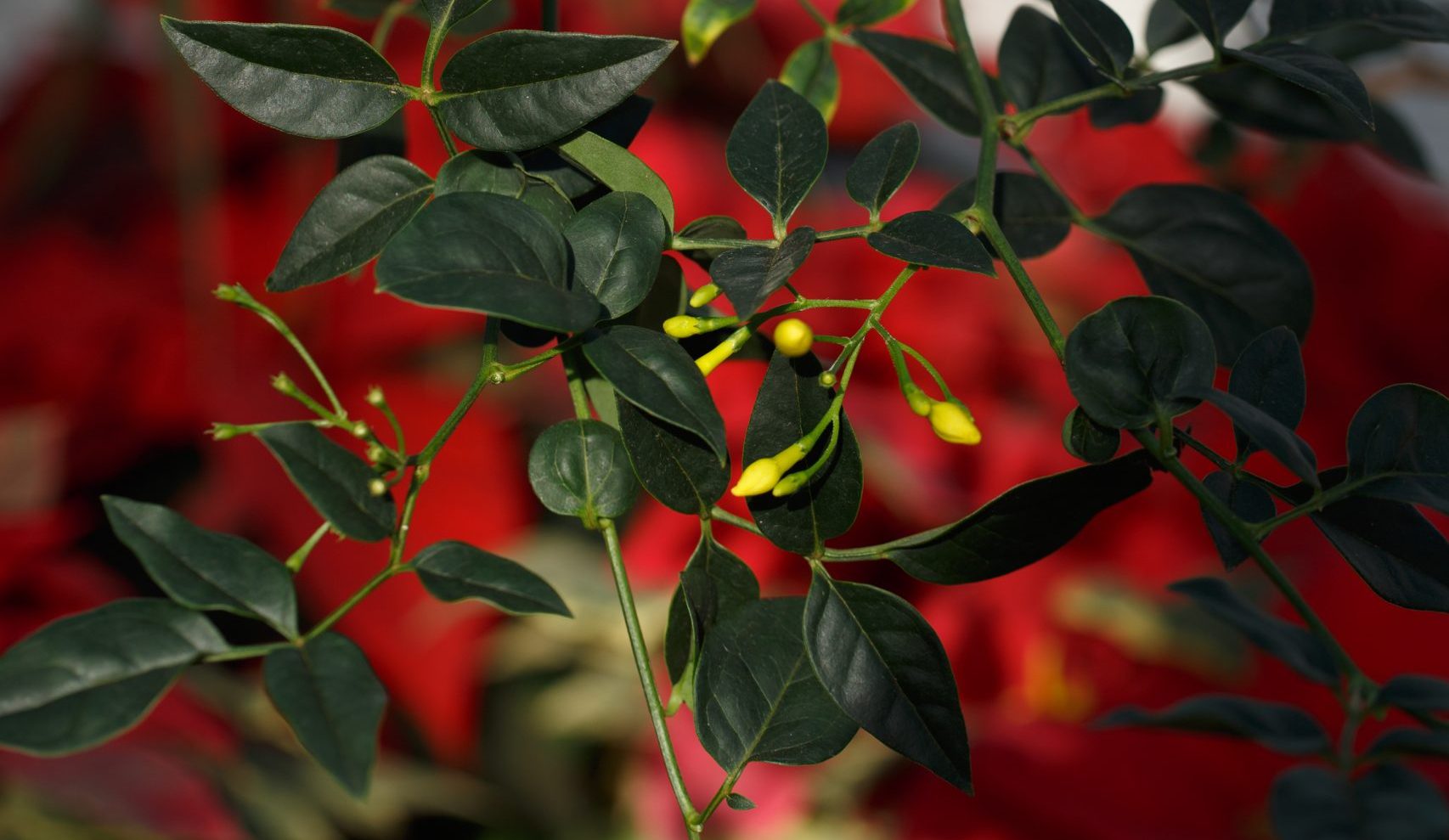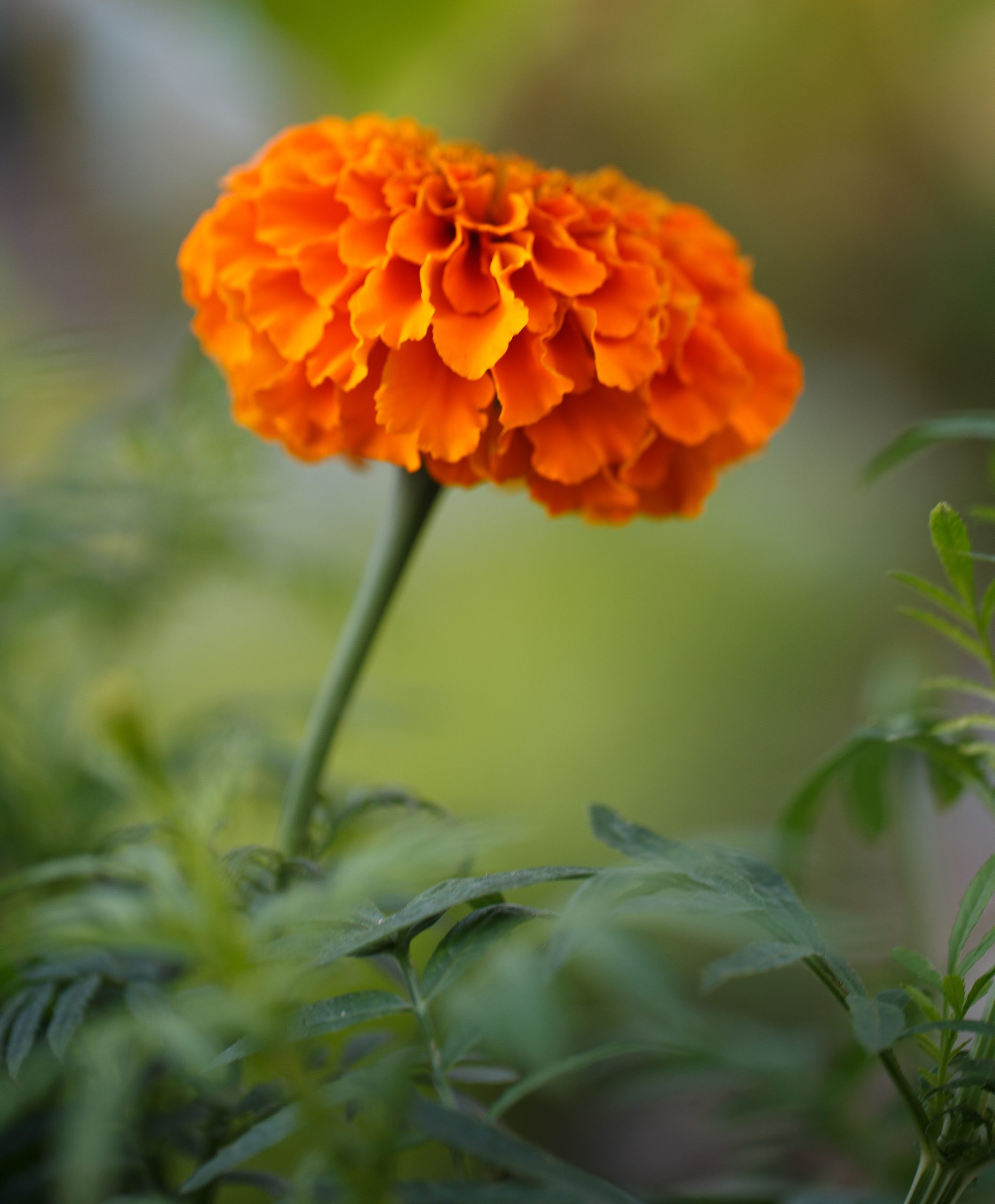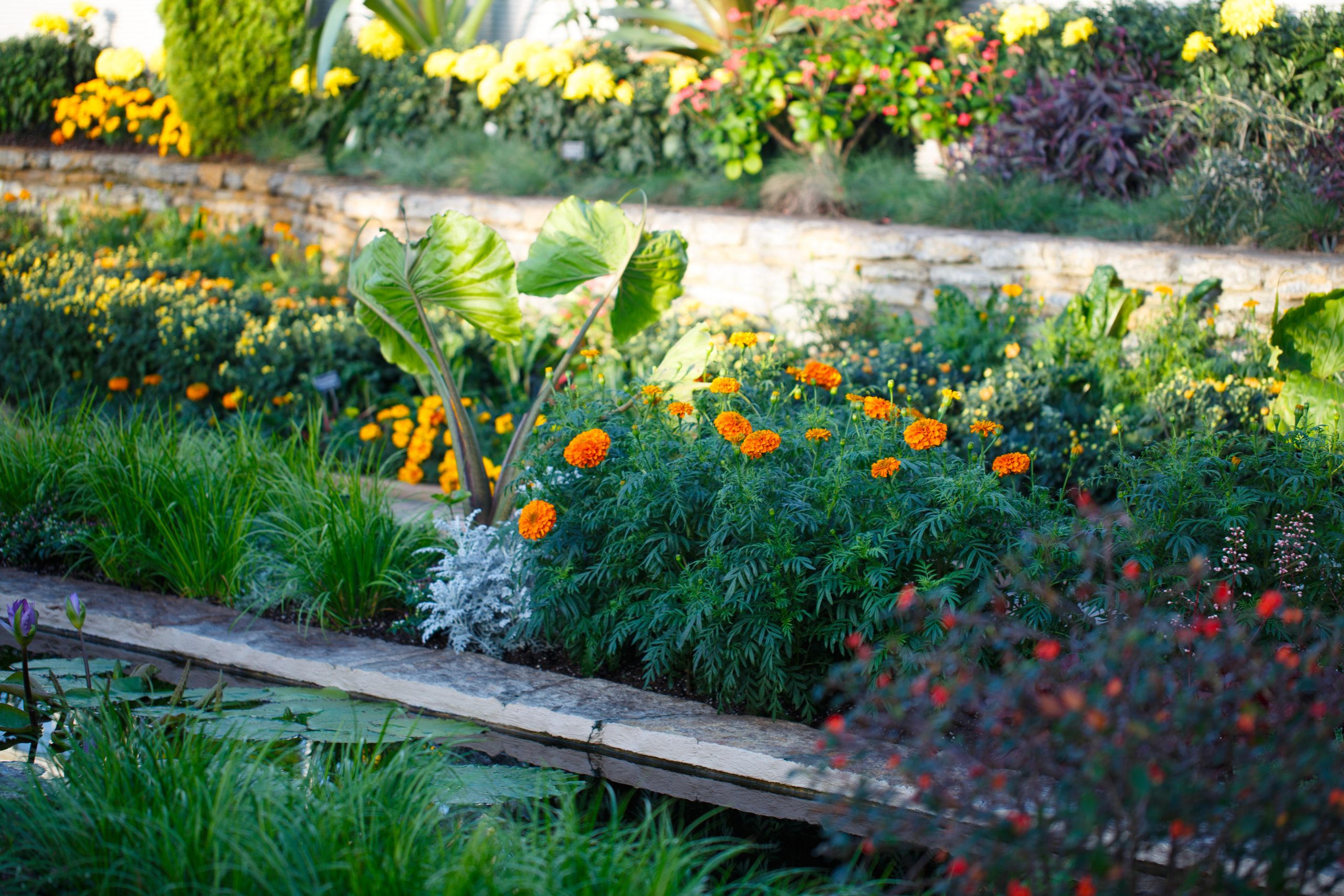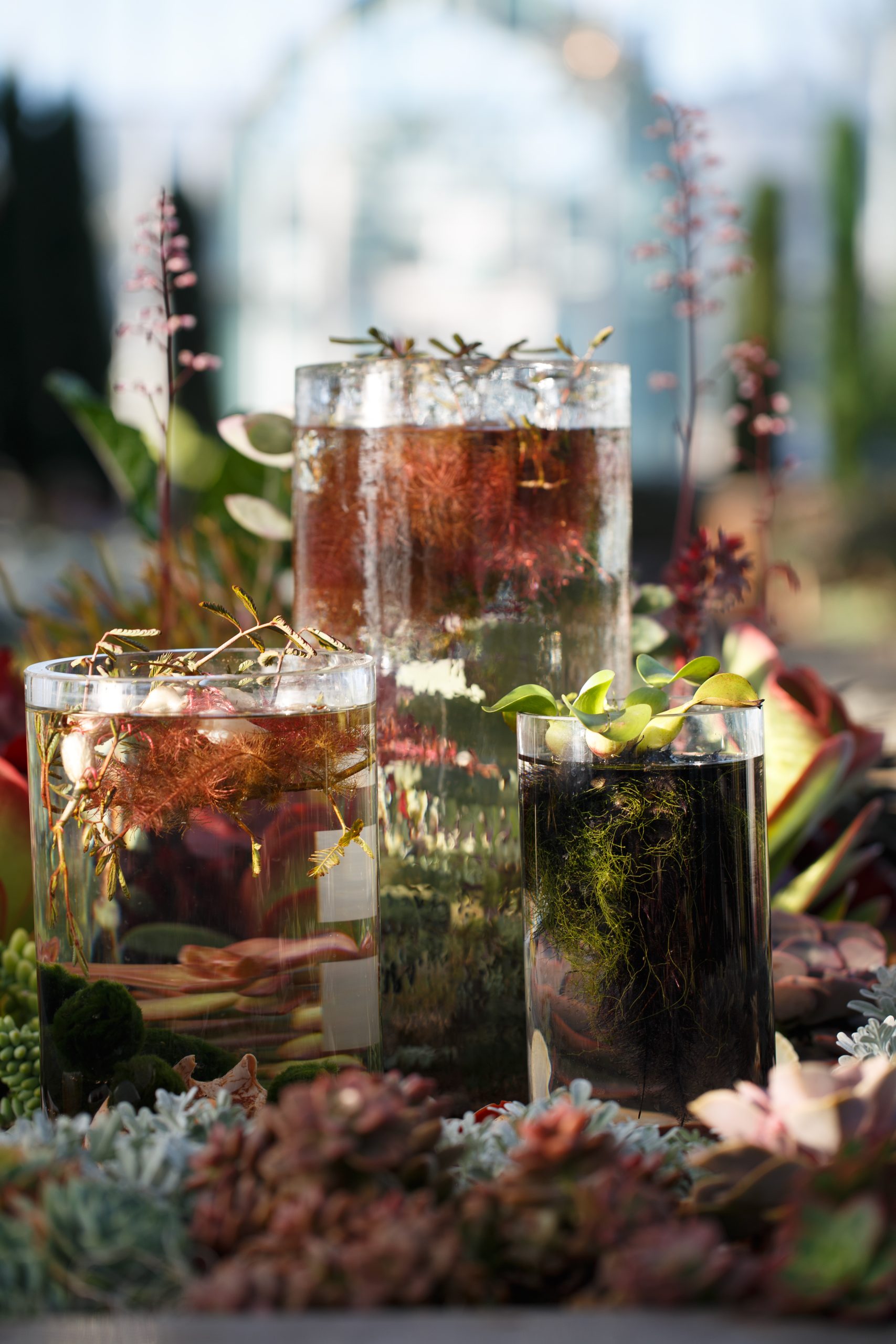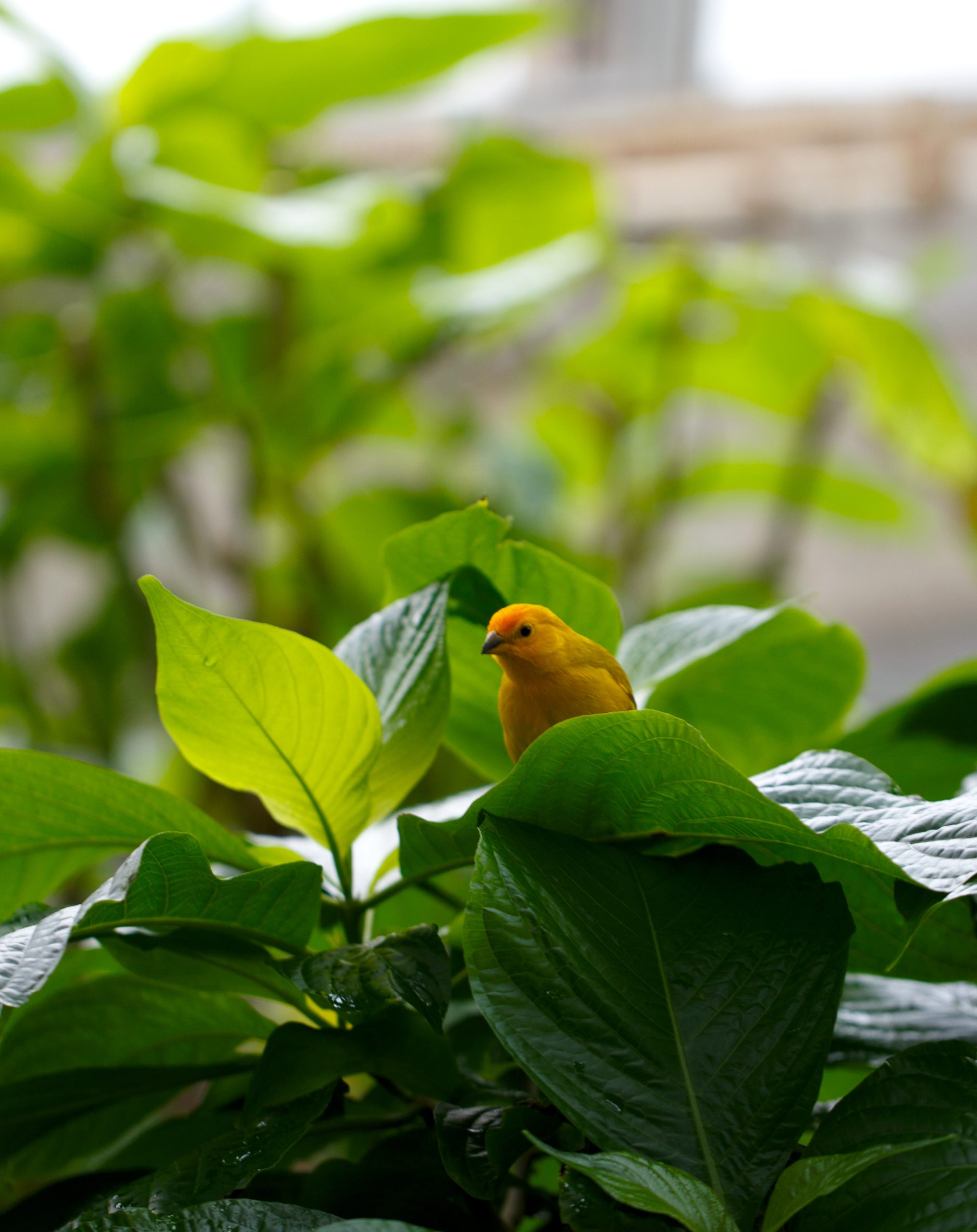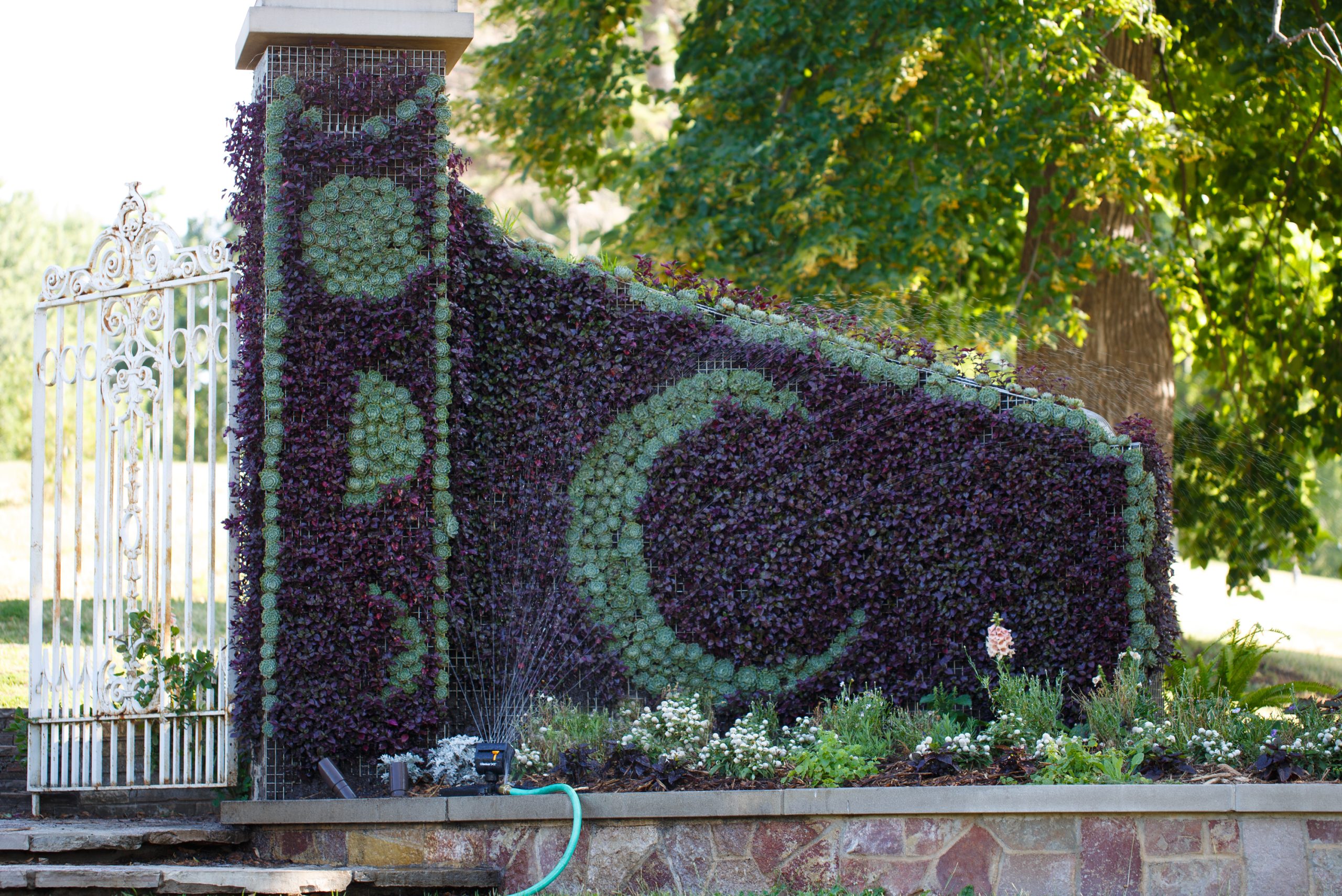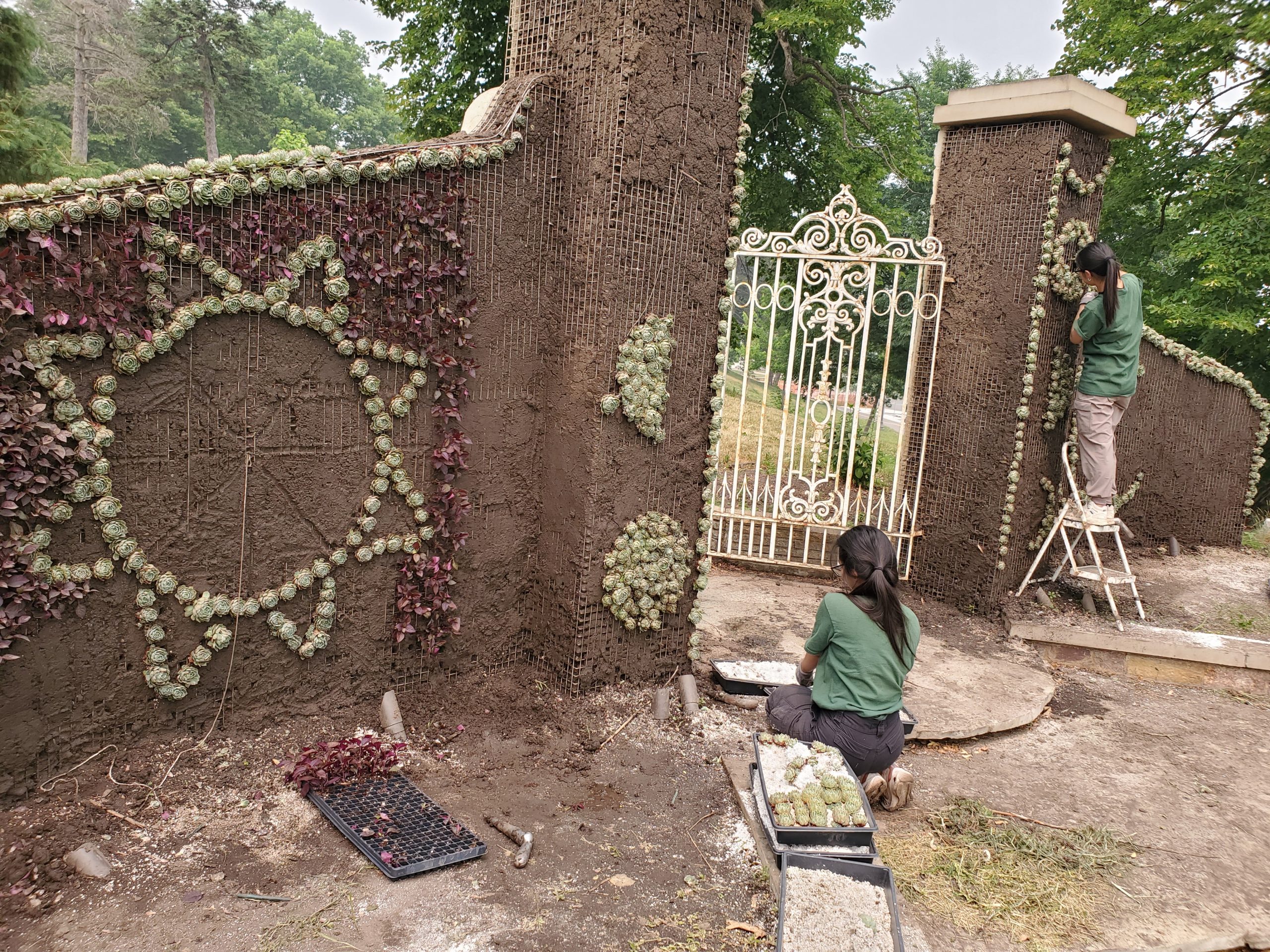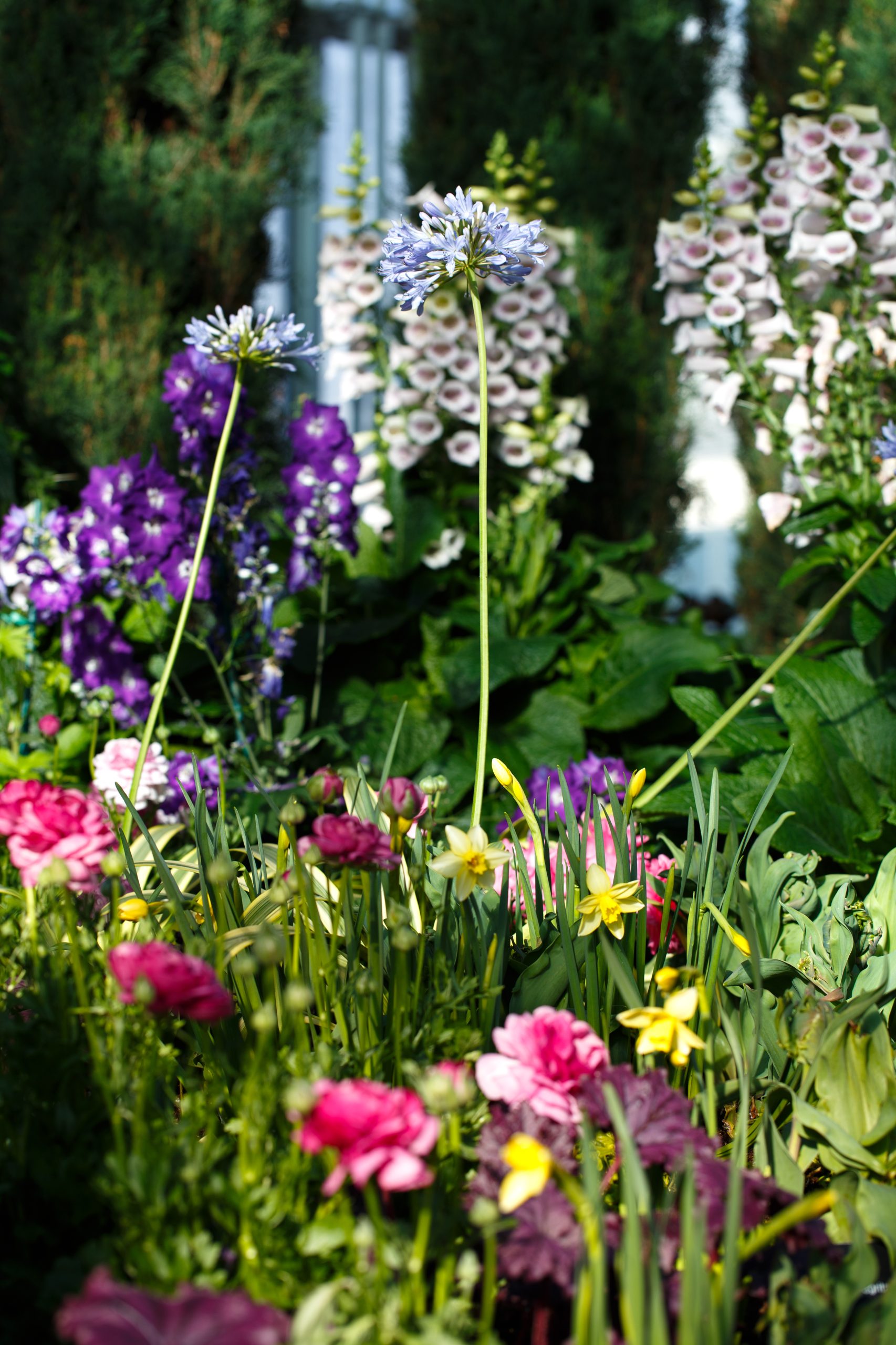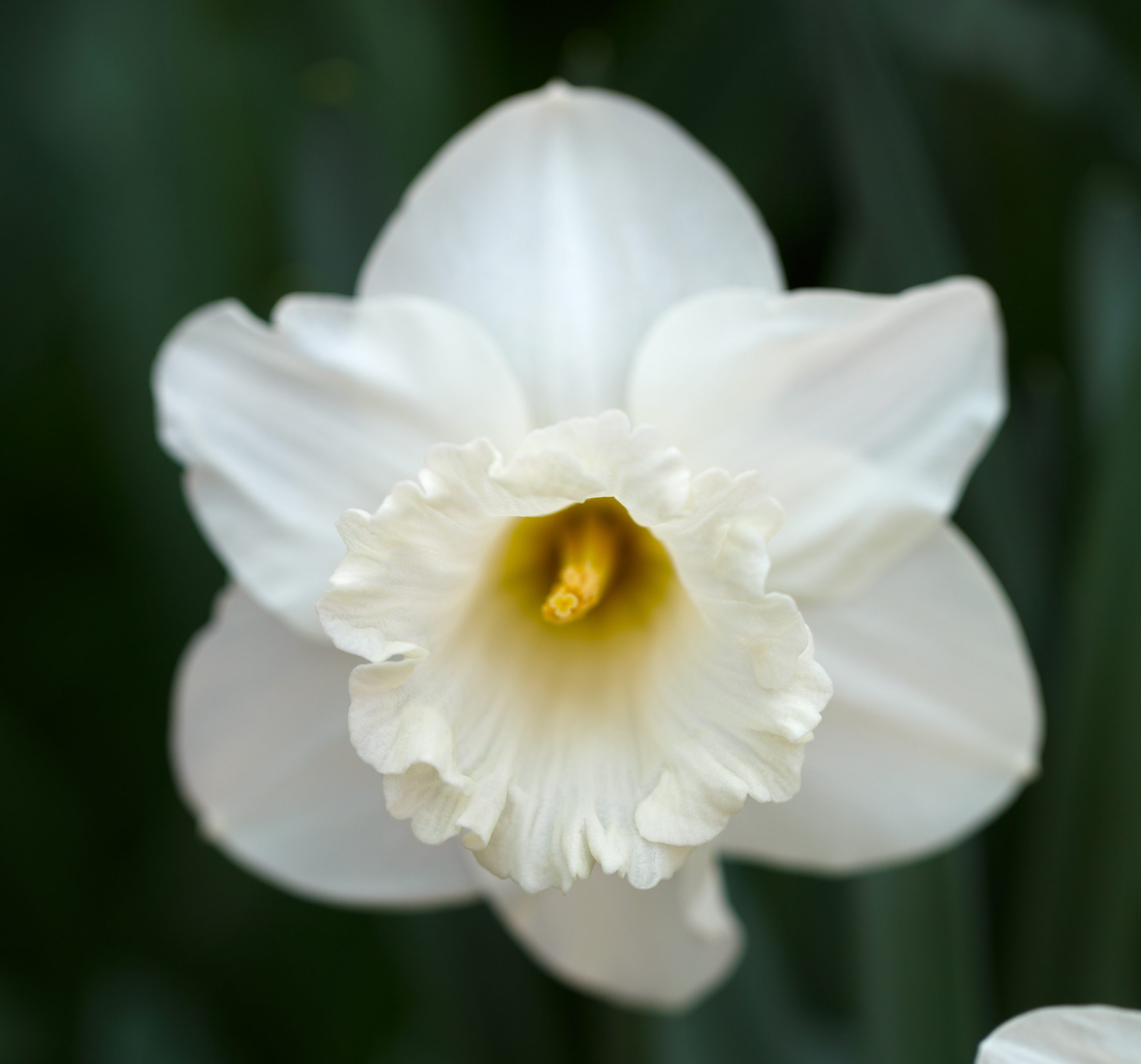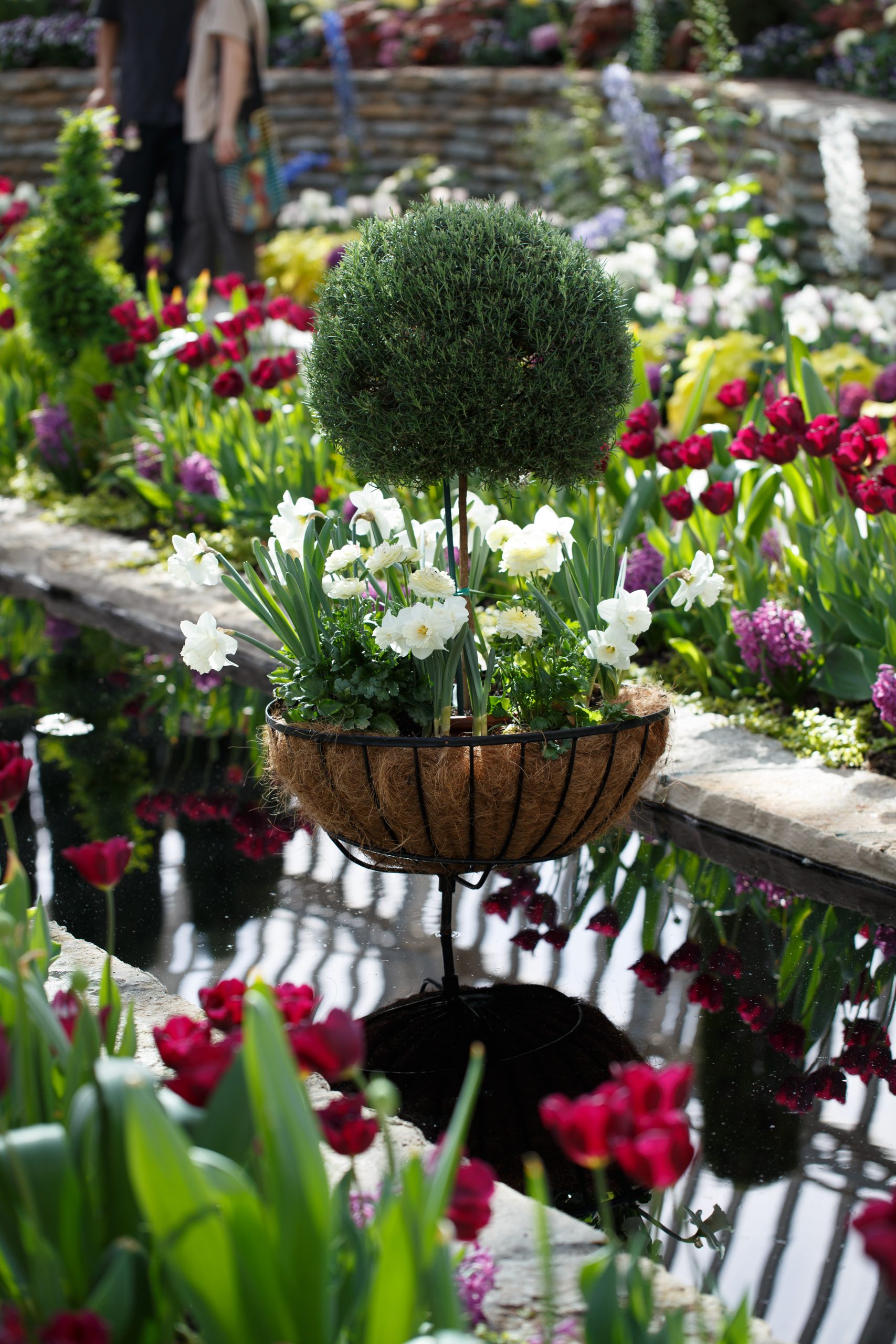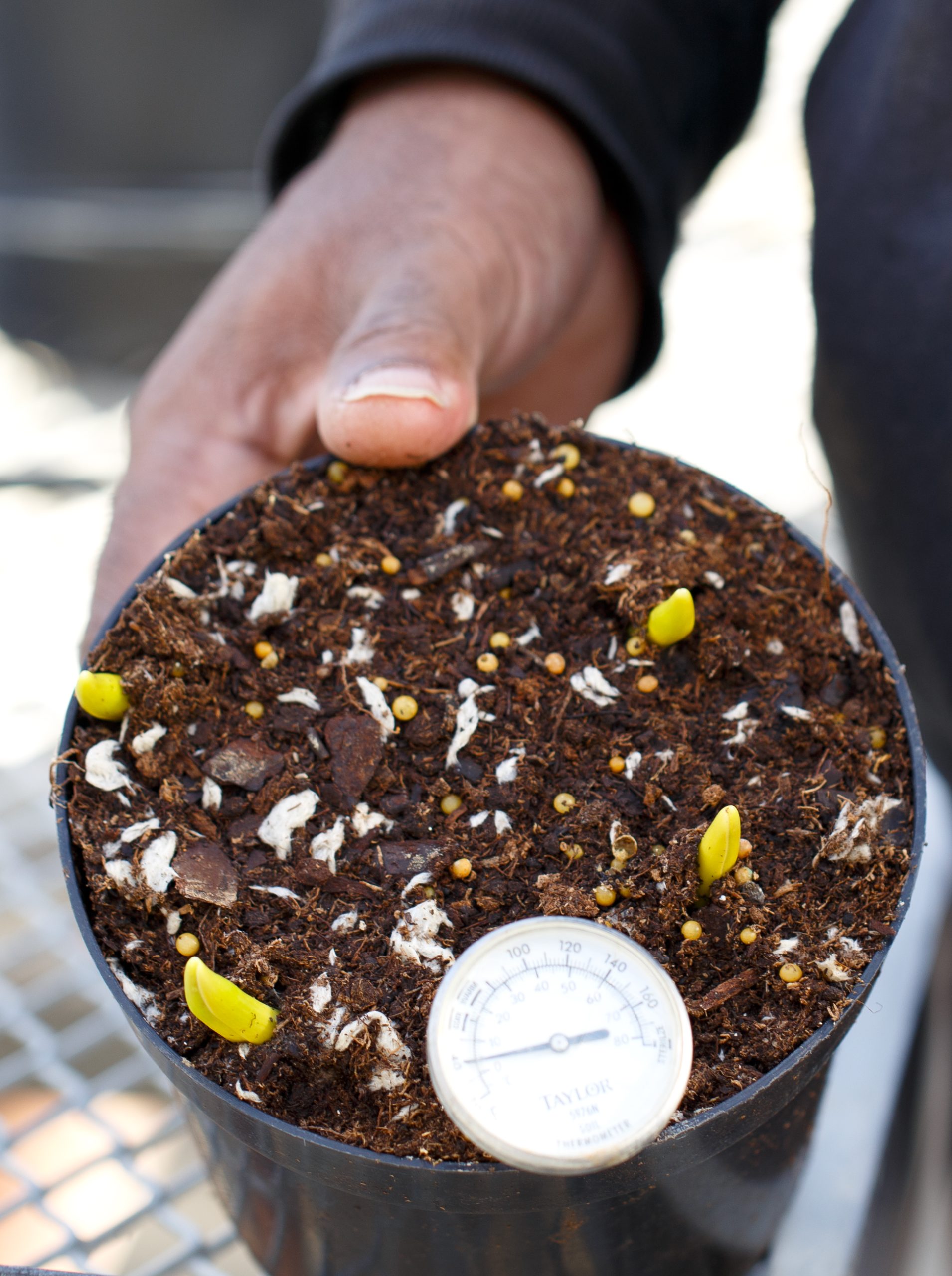The diverse color possibilities of Poinsettias are now on display at the Holiday Flower Show, featuring ‘Ferrara’ red, variegated ‘Tapestry’ plants with yellow & green leaves, and yellow ‘Golden Glo’ Poinsettias. Yellow flowering kalanchoe, hibiscus, and lemon cyprus add tropical accents to one of the most visited flower shows of the year.
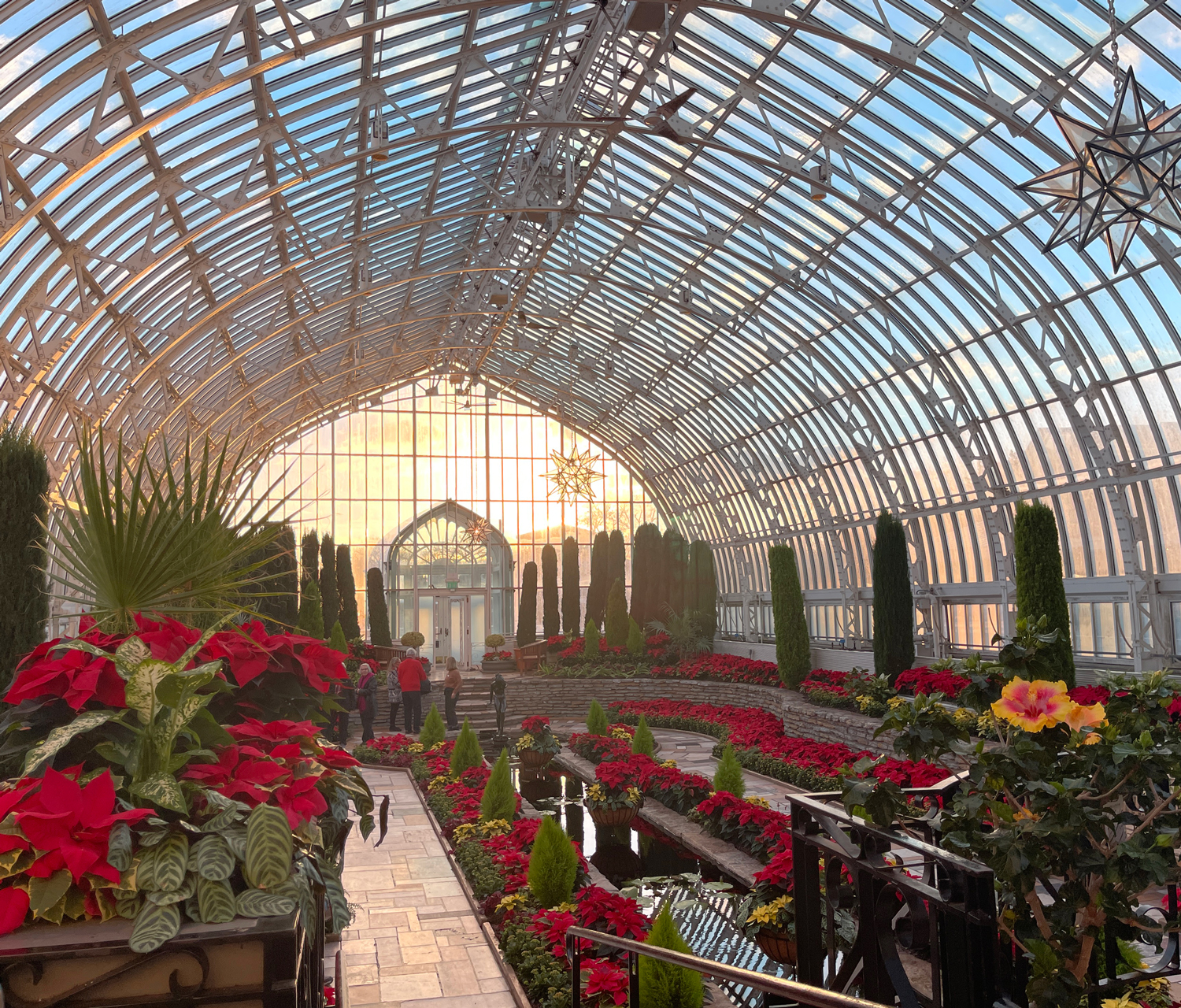
Known as the flor de nochebuena—or Christmas Eve Flower—in their native Mexico, it’s no wonder Poinsettias have become the quintessential plant of the season. Available in endless shades of reds, pinks, creams, and greens, Poinsettias are among the most economically valuable plants in the world, with nearly 70 million sold each holiday season in the United States alone.
Marjorie McNeely Conservatory horticulturist Bo Akinkuotu knows just what it takes to make these delicate tropical plants come to life. Back in June, he planted more than 1,000 Poinsettias to ensure they’d be at their peak just in time for the Holiday Flower Show now on display in the Sunken Garden through January 7.

“It’s a tricky thing, because Poinsettias are a touchy, finicky plant, especially for growing at home,” Akinkuotu says. Though they’re deeply associated with the winter holidays, “They’re a tropical, heat-loving plant, and they don’t like to get too wet, or they’ll rot, and they don’t like to get too dry, or they’ll wilt. You have to find that sweet spot between the two.”
A member of the Euphorbia family, Poinsettias can only come to life during the darkest days of the year. “The interesting thing about them is that they really need these shorter days to start showing and changing their colors through the bracts, which are the showy part of the plant,” he says. Climate control is another key ingredient to keeping these plants at their best. “They’re unhappy in chilly weather, but if you can keep the temperature in the low to mid 70s, they’ll usually last until the end of the holiday season.”
Thanks to your contributions to Como Friends, the Marjorie McNeely Conservatory’s Holiday Flower Show is always free, and is open from 10 a.m. to 4 p.m. every day of the week, including Christmas and New Year’s Day.
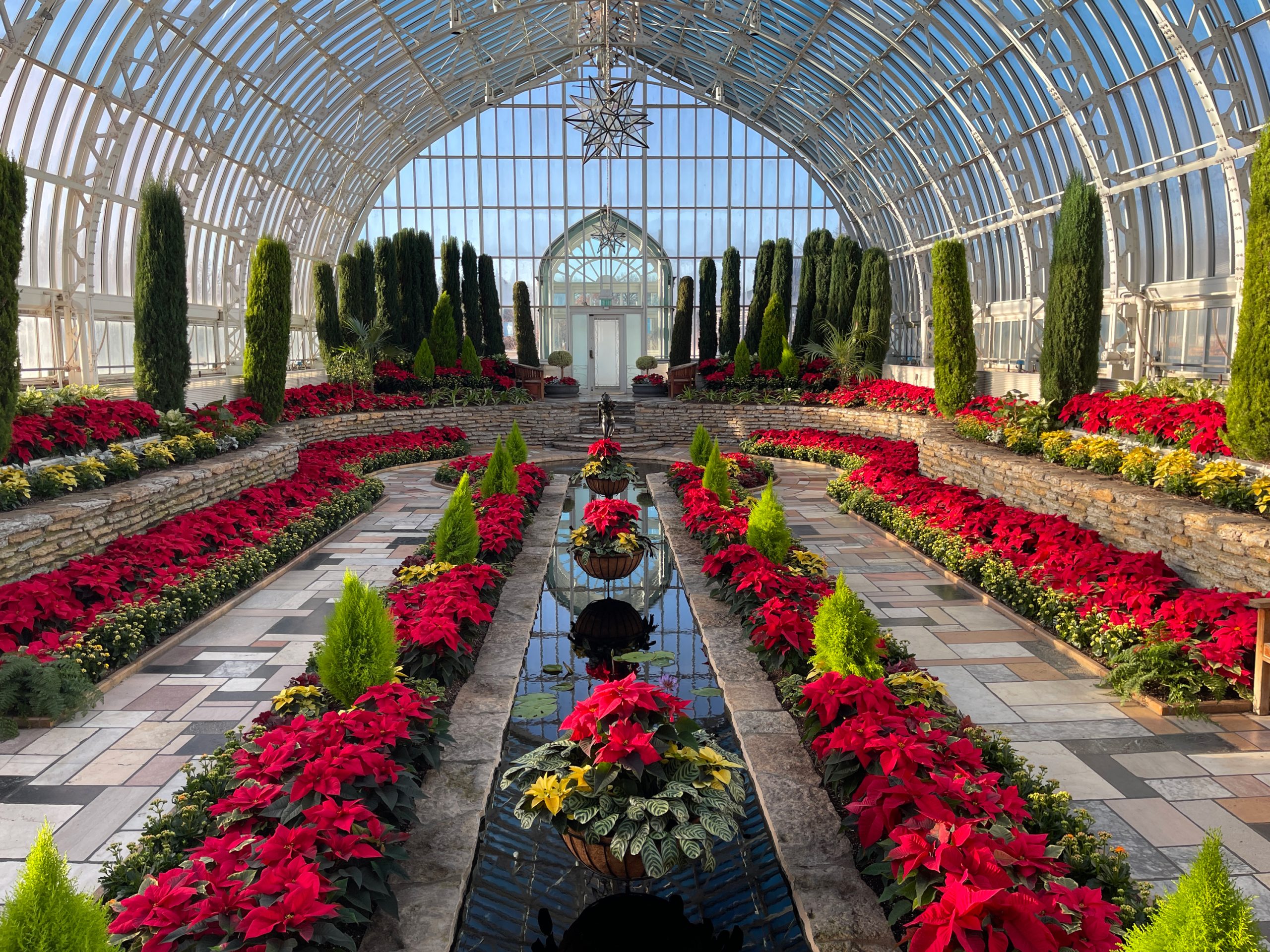


The dazzling colors of Día de los Muertos are the inspiration for the second half of the Sunken Garden’s fall flower show now on display.

“As gardeners, we’re always interested in trying new things in traditional spaces,” says Lisa Philander, the Marjorie McNeely Conservatory’s horticulture curator. “The goal was to create a feeling of undulating waves of color, rather than making each side of the room a mirror of the other.”


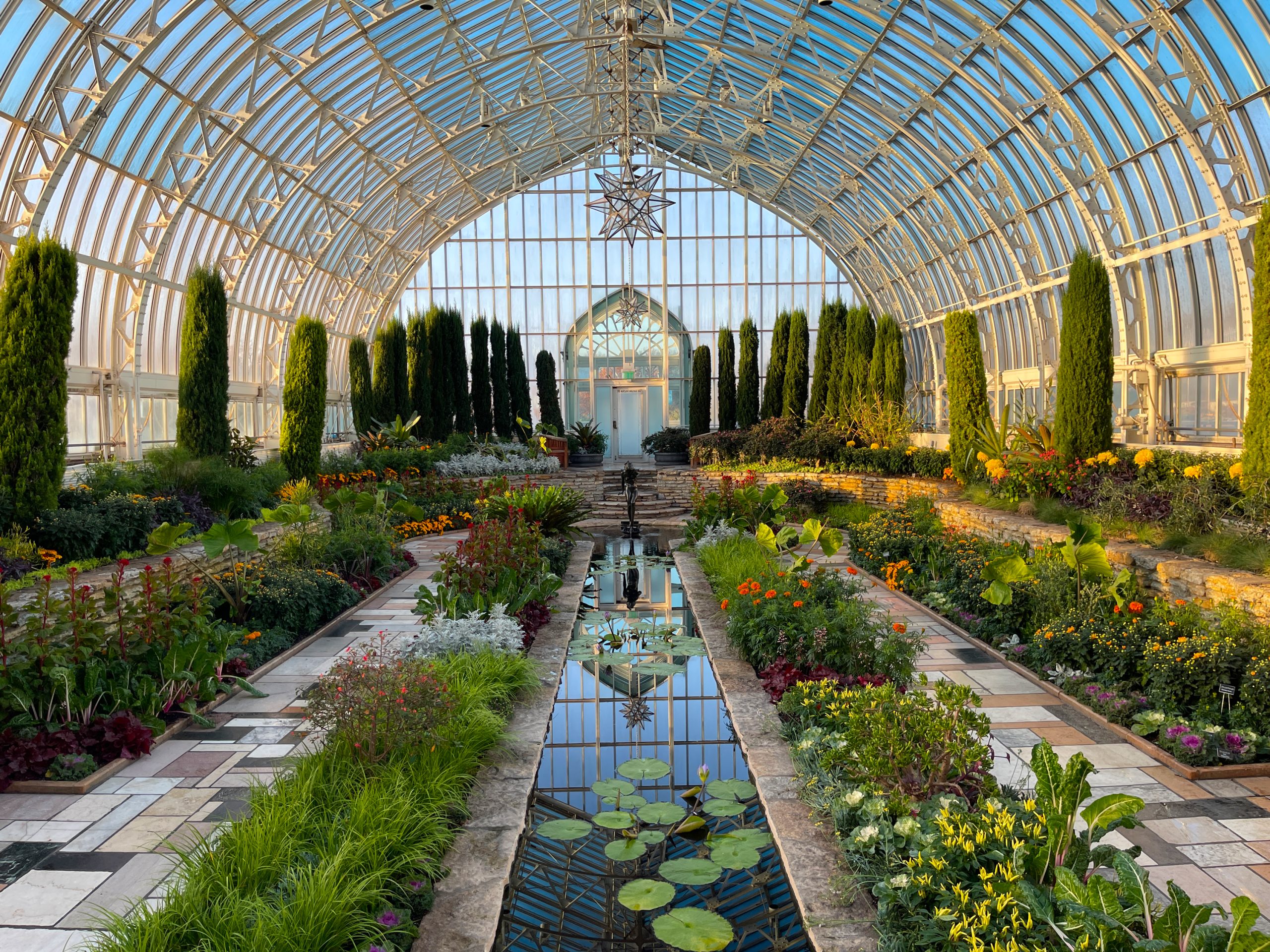
The dazzling colors of Día de los Muertos are the inspiration for the second half of the Sunken Garden’s fall flower show now on display. With orange and yellow mums, accented by bright magenta celosia, this season’s flower show is a fiesta for the senses.
One featured flower is the orange marigold, a Mexican native plant known by the Aztec name cempasúchil. A flower that’s strongly associated with the holiday, the color and fragrance of marigolds are said to show departed souls the path to their family homes. Gardening sources report that demand for marigolds has also risen considerably since the 2017 Disney Pixar film Coco, which introduced a worldwide audience to the customs of Día de los Muertos.
Visitors to the Sunken Garden may also notice that the design of this season’s Fall Flower Show is asymmetrical, breaking up the bilateral design pattern that’s commonly been used in the room. “As gardeners, we’re always interested in trying new things in traditional spaces,” says Lisa Philander, the Marjorie McNeely Conservatory’s horticulture curator. “The goal was to create a feeling of undulating waves of color, rather than making each side of the room a mirror of the other.”
Always free to visitors thanks to your contributions to Como Friends, the Sunken Garden Fall Flower Show is now on display through November 26.
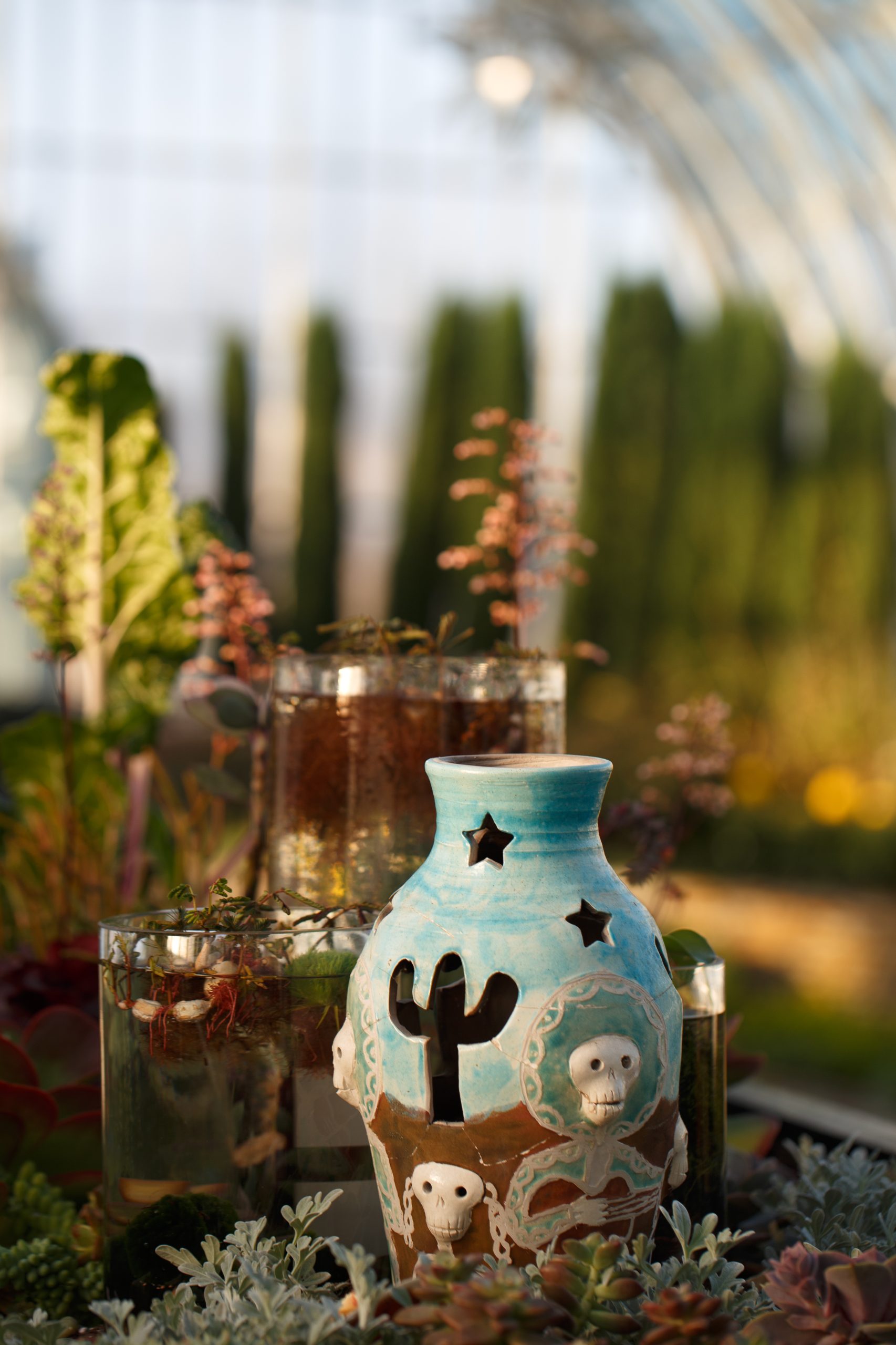

Como’s chrysanthemum show has been a tradition since 1915, but you’ve never seen a fall flower show quite like this one! With an “Under the Sea” theme, the display includes anemone mums, green stingray colcassia, spider mums, and succulents that combine to create a cool octopus’s garden vibe in Minnesota’s most beautiful room. Check out this photo preview, and make plans to see it before October 30, when the fall flower show’s second half transforms into a celebration of Dia de los Muertos.
Did you know that the succulents used in the Fall Flower Show are the very same succulents used in the Gates Ajar display this summer!


Open from 10 a.m. to 4 p.m. every day, the Fall Flower Show is always free to visitors, thanks to your contributions to Como Friends.
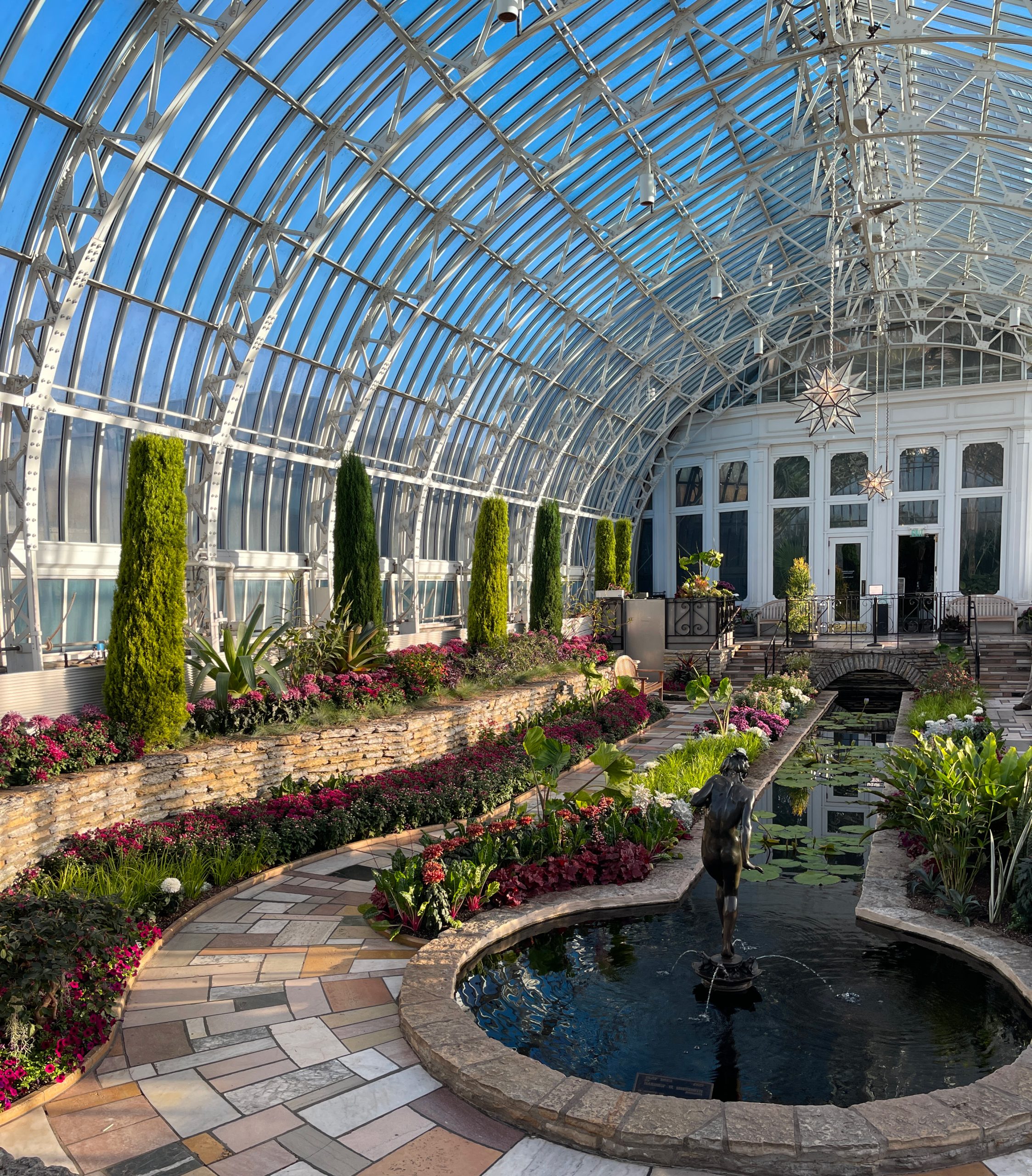
With chrysanthemums playing the starring role in this season’s Fall Flower Show, it’s a guarantee that thrips will also be part of the cast.

Also known to gardeners as thysanoptera or thunderflies, these needle-thin sucking insects love to feed on mums, causing damage to plants, or worse, transmitting viruses from one plant to the next.
Fortunately, Como’s horticulturists have a tiny but mighty weapon to keep thrips from ruining the show. Known as the cucumeris mite, this half-millimeter predator insect has just been deployed throughout the mum crop destined for the second half of the Fall Flower Show. With an appearance like that of a transparent wood tick, and the ability to prey on thrips and survive on plant pollen, these super small super predators play an important role in the Marjorie McNeely Conservatory’s Integrated Pest Management plan.
“People sometimes think that spraying pesticides is the only way to control pests, but integrated pest management is an approach that combines anything you might do to make a plant healthier, from the condition of the soil it’s growing in, to your nutritional program, to how you’re pruning the plant,” explains Como horticultural supervisor Bryn Fleming. While Como has been a low-pesticide growing facility for decades, Fleming says, “our reliance on beneficial insects has increased more recently,” as the gardening industry embraces more sustainable ways to manage greenhouses and gardens.

While beneficial bugs show great promise in cutting the use of pesticides, monitoring how well predator insects perform can be time consuming and complex. What’s the right dosage of beneficial insects for a particular plant or crop? How do shifts in such inputs as light, water or temperature affect the efficacy of beneficial bugs? Are some pest predators better than others?
To help answer those questions, the Marjorie McNeely Conservatory is now equipped with a new integrated pest management scouting system called IPM Scoutek. Made possible by your support for Como Friends, this new digital technology tracked on a tablet allows horticulturists to collect data from greenhouses and gardens to make even more informed decisions about how to care for crops and manage pests.
“This technology is used by large-scale growers who are producing bigger agricultural crops, but is also used for nursery or floriculture production.” says Horticulturist Jen Love, who recently shared news about Como’s software scouting system during an American Public Gardens Association symposium at the Franklin Park Conservatory and Botanical Gardens in Columbus, Ohio. “As far as we know, as a public garden the Marjorie McNeely Conservatory is an early adopter trying this approach, and there’s a lot of interest from other institutions in seeing how this process works. If it’s successful, it’s a model we can share with other botanical gardens.”

As Como’s horticulturists discover what digital technology can do for pest management, Fleming says the Conservatory’s early adopters are already impressed by what they’ve seen. “I think this software is going to help us to keep track of things at a much closer level, so when problems come up we can respond to them even sooner,” she says. “To care for a living collection requires constant adaptation, and this technology will help us be a little more proactive than reactive.”
The biodiversity of Como’s rainforest habitat requires complex care

“When we try to pick out anything by itself,” the famous naturalist John Muir once wrote, “we find it hitched to everything else in the Universe.”
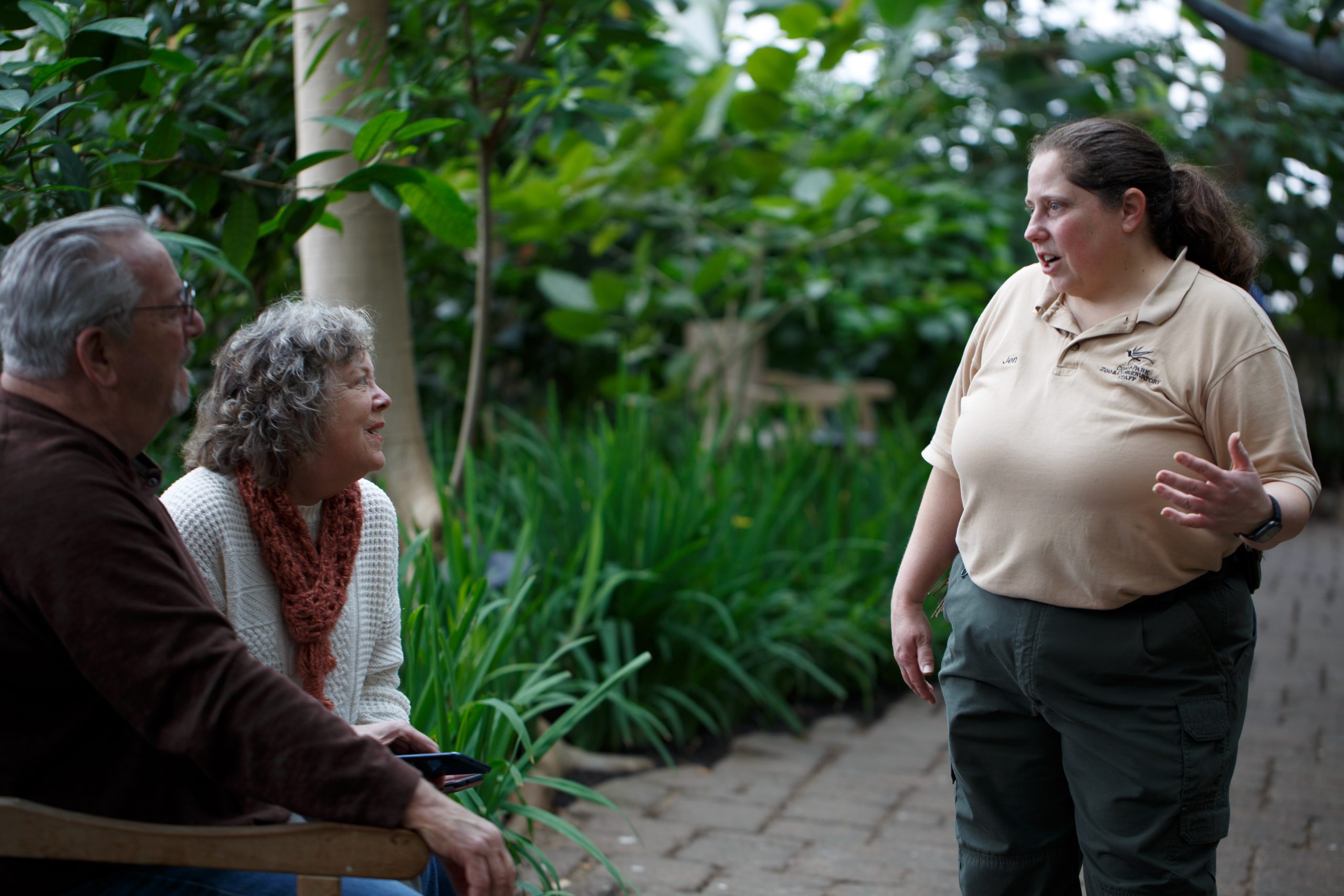
The profound interdependence of plants, animals and people is one of the lessons Como Park Zoo & Conservatory strives to convey to more than a million visitors every year, and nowhere is that lesson more evident than in Tropical Encounters. Opened in 2006, the immersive rainforest habitat features an extensive array of tropical plants and trees, and an equally diverse range of animals, from high-flying tanagers, to a slithering anaconda, to Chloe, Como’s beloved free-ranging sloth.
With so many living things under one roof, Como Zoo keepers and Marjorie McNeely Conservatory horticulturists collaborate closely within Tropical Encounters to ensure that making a change in one corner of the habitat doesn’t have negative impacts for other residents of the rainforest. That’s why the Tropical Encounters team is taking its time on a major soil replacement project this season paid for by your contributions to Como Friends.
Visitors this summer may notice that horticulturists are taking a staged approach to the process, removing spent soil from one location at a time, to make sure that the root systems of rainforest trees and the animals that live in the vicinity are all thriving. The effort is a little bit like repotting a giant terrarium, says horticulturist Diane Rafats: “We do take special care in this habitat. Everything we do here can affect everything that lives here.”

Private support secured by Como Friends is critical to making behind-the-scenes improvements that keep every corner of the Marjorie McNeely Conservatory healthy and thriving. This year, Como Friends’ funding will also support a new lighting system for the North Garden’s gorgeous collection of economic plants, a new sound system to improve the experience for visitors, and a new design plan to renovate and repair Como’s popular Victorian Water Garden pool. Thank you!
A horticultural tradition with roots that go back to 1894, Como’s beloved mosaiculture is back in season
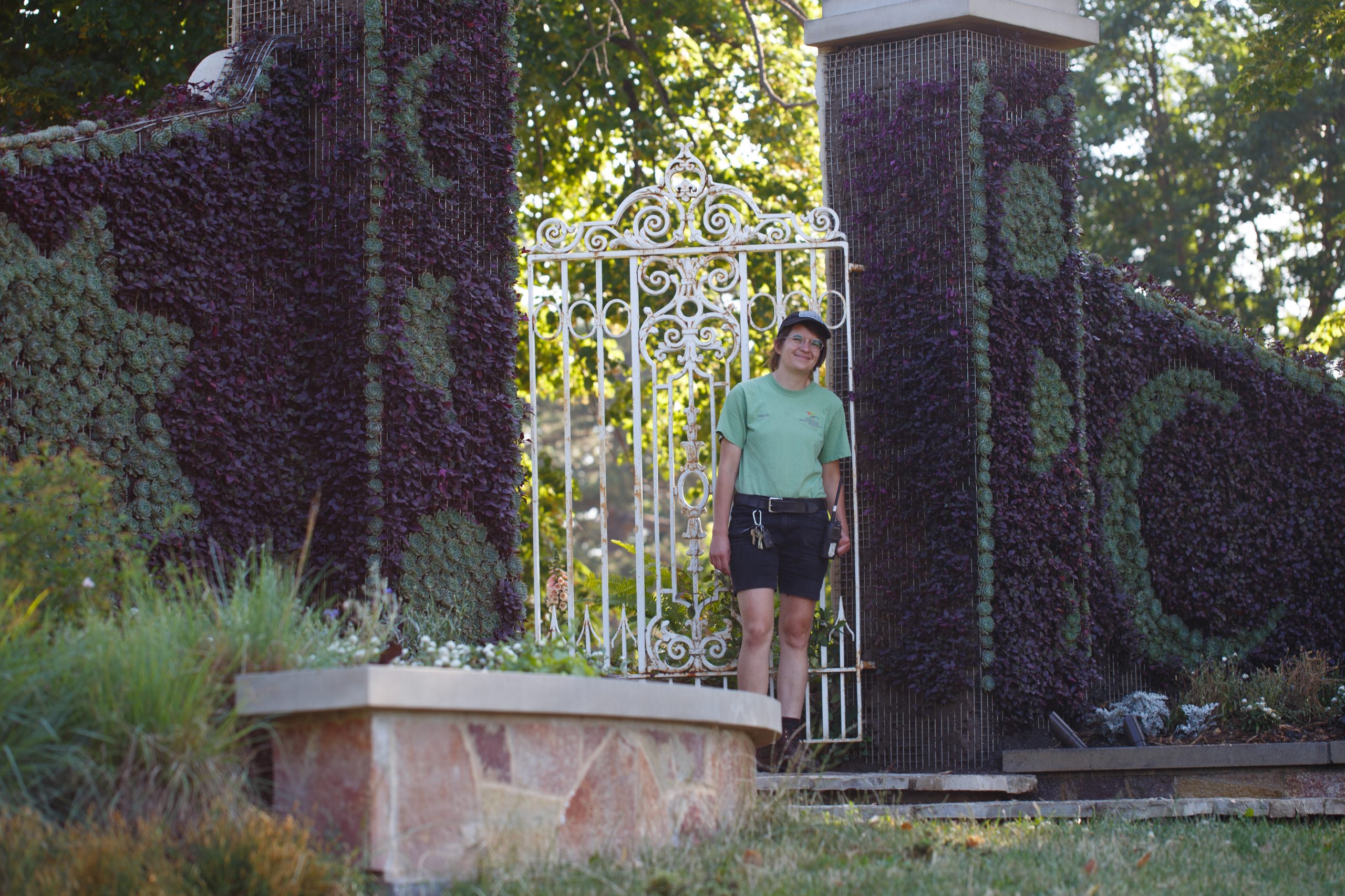
Marjorie McNeely Conservatory assistant gardener Marie Day was wrapping up her work watering the Gates Ajar installation recently when a nearby pedestrian caught her eye to convey a message.
“She didn’t speak English, but she pointed to Gates Ajar and she started clapping,” Day recalls. “She got the point across.”



Located just east of Lexington Parkway, Gates Ajar earns applause every year from visitors who appreciate the fresh new ways Como’s horticulturists have interpreted this historic horticultural attraction. Created back in 1894, when building topiary-like sculptures from plant material was the height of European flower fashion, Gates Ajar has been a fixture at Como for more than 100 years. With a name inspired by Henry Wadsworth Longfellow’s 1851 poem “The Golden Legend,” Gates Ajar is essentially an elaborate upright flower bed that requires more than 100 gardener hours to bring into bloom.
Day, who designed this year’s installation, says that work starts with bringing new soil into the structure, a “mudding” process similar to putting up drywall. Next, a team of four gardeners and five interns began planting this year’s sun and moon motif out of nearly 10,000 Conservatory-grown annual plants—a mix of colorful alternanthera and echeveria, a fast-growing succulent.
Once fully installed, Gates Ajar requires continued and painstaking care, from hand-pulling weeds and trimming overgrowth, to nearly 45 minutes of watering each day. The vertical structure can also be a challenge, says Day. “I’m not very tall, so I have to bring in a step ladder and try not to crush the plant material below me.”
Day says she took her inspiration this year from the more traditional floriculture of the 1940s and 50s, but if she gets a chance to design 2024’s installation, purple would be the dominant color. “Next year is the 40th anniversary of ‘Purple Rain,’” she says. “I’m pretty sure that would be a big crowd-pleaser.”

the Summer Flower Show is always free to visitors, thanks to your contributions to Como Friends
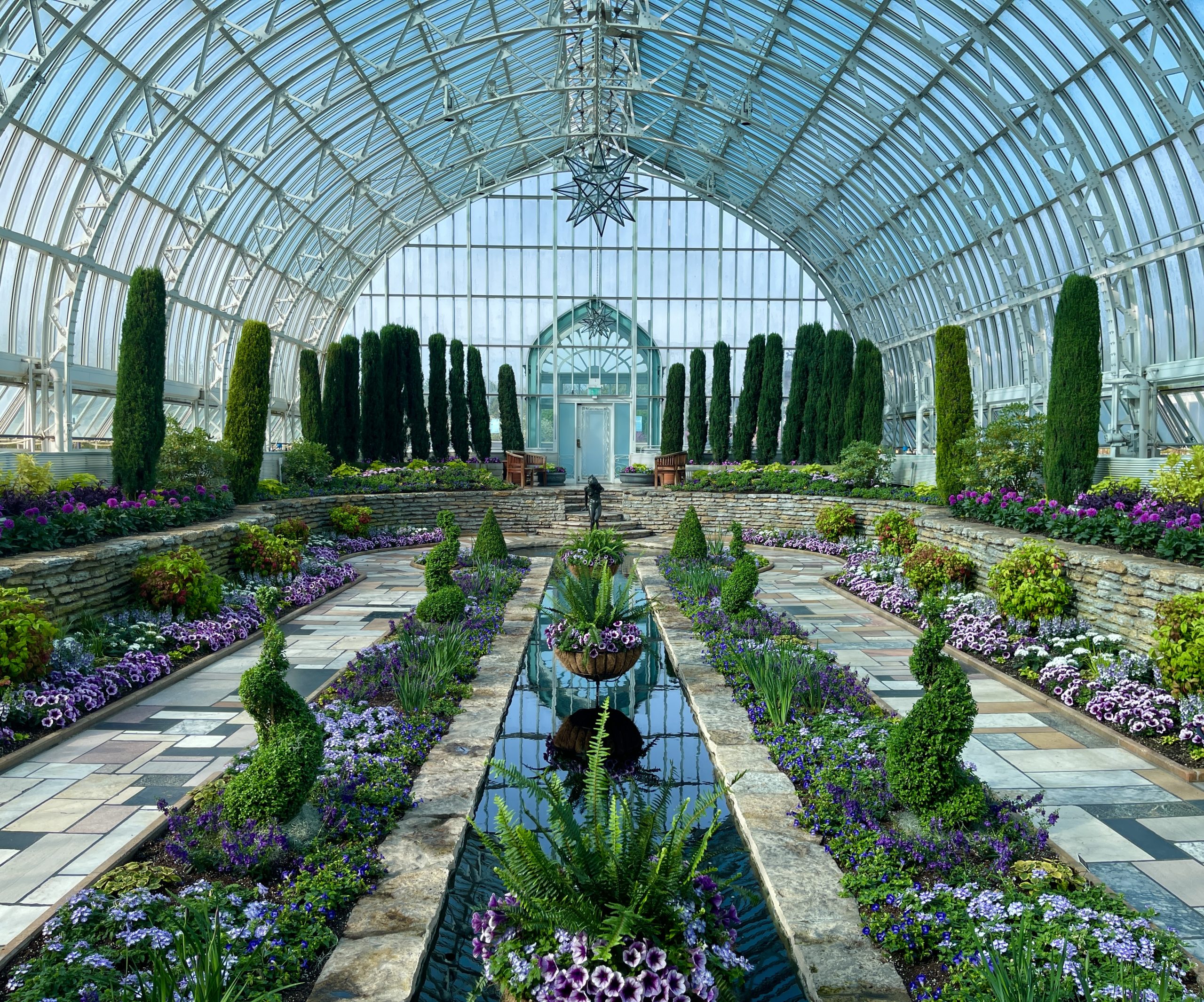
Summer starts early in the Sunken Garden, where the Marjorie McNeely Conservatory’s Summer Flower Show is already in bloom. Brimming with bright colors and new varietals, the year’s longest running flower show is a great place to find inspiration for your own backyard. Open from 10 a.m. to 6 p.m. every day, the Summer Flower Show is always free to visitors, thanks to your contributions to Como Friends.
Volunteers from Minnesota Bonsai Society have helped the Marjorie McNeely Conservatory cultivate one of the Midwest’s best collections
With their Lilliputian leaves, undulating branches, and fairytale trunks, bonsai can sometimes seem like they come from another world. That’s why Como horticulturist Reva Kos tries to take the mystery out of these miniature potted trees when she talks with curious visitors at the Marjorie McNeely Conservatory.
“I want visitors to know that really anyone can create a bonsai,” says Kos, who has served as the curator of Como’s bonsai collection for the past decade. “They’re special trees because of how we take care of them, but they’re just trees. They’re not magically small—they’re just well loved.”
Over the last three decades, the Marjorie McNeely Conservatory’s bonsai collection has been very well loved—not only by Como’s horticultural staff, but also by the Minnesota Bonsai Society. Starting in the early 90s, when First Bank donated a sizable collection of bonsai to the Conservatory, a long list of dedicated volunteers from the Minnesota Bonsai Society (MBS) have contributed their time and expertise in training one of the best bonsai collections for public display in the Midwest. “We wouldn’t have the collection we have without the Bonsai Society,” says Kos. “Working with our volunteers is a collaboration. Everyone who works with bonsai is opinionated about what should happen next with a tree, and it’s fun to bounce ideas off each other.”
MBS member Kirk Hedberg agrees. “With other kinds of artwork, like painting or sculp- ture, you’ll reach a point where you know it’s done, but the thing that’s fascinating about bonsai is that you’re never done—the tree keeps growing and adapting, and you come to an agreement with the tree over a long period of time about how it’s going to look. The tree has ideas and you have ideas, and they’re not always going to mesh.”
A bonsai enthusiast since the 1970s, Hedberg, a retired chemistry teacher from Afton, makes the trip to Como every week to help prune, wire, clean and repot the Conservatory’s collection of more than 130 trees, which range from traditional Japanese maples and junipers, to Ponderosa pines from the Rocky Mountains and Tamarack from Minnesota’s north shore. The wide variety of species, sizes and characteristics of Como’s bonsai allows Kos to select the trees that are blooming or look the best at a given moment for public display in The Ordway Gardens. The upcoming Mother’s Day Bonsai show, slated for May 13 and 14, is a great time to discover the beauty of bonsai, with a few of Kos’ and Hedberg’s insider tips.
Leaning In: Bonsai trunks often tip toward the viewer, a visual trick that draws viewers in to the miniature world bonsai masters are trying to create. But leaning in is not a requirement. “Once you learn all the rules of bonsai, you discover that some of the most beautiful trees break them all,” says Hedberg.
Asian Roots: Bonsai has roots that go back to China in 700 AD where crafting elegant potted trees or “pun-sai” was only for the elite. By the 1200s, bonsai had become a mainstay of Japanese horticulture, spreading through Europe and the West by the late 19th century. As a result, every culture has a certain style, says Hedberg, from the more densely “helmeted” trees you might see in a European collection, to the airier American style influenced by California bonsai master John Yoshio Naka, who believed branches must “leave room for the birds to fly through.” No matter where they come from, Kos says, bonsai are typically planted in a soilless mixture of pumice, lava rock, and akadama, granular clay-like material mined from the volcanic soil near Japan’s Mount Fuji.
Bonsai Styles: Como’s collection includes a wide range of bonsai styles and plant materials, like the Ponderosa pine featured above. Each inset also features a distinct aesthetic style: examples shown above, the Trident Maple with an S-shaped trunk is trained in the informal upright style (Moyogi ); the Japanese Greybark Elm are arranged in a forest style (Yose-ue); the White Cedar represents the formal upright style (Chokkan); and the Chinese Elm features a semi-cascading style (Han-kengai), with branches that drop below the top of the pot.
Artificial Aging: Some of Como’s bonsai are more than 450 years old, but many more are just trained to look that way, with winding trunks and flaring root systems (Nebari) that make the tree look like it’s survived the elements. “Age is an important part of the aesthetic,” says Hedberg. “If you can make a 20-year-old tree look like it’s 200 years old, that’s a successful bonsai.”
Nearly a year in the making, the Marjorie McNeely Conservatory’s Spring Flower Show is finally in bloom
Since her arrival last year, Dr. Lisa Philander, the Marjorie McNeely Conservatory’s new horticultural curator, has been digging in to every corner of Como’s horticultural operations, from climbing ladders to prune the fig trees in the North Garden, to drawing up the design for this season’s Spring Flower Show.
Starting back in July 2022, Dr. Philander selected the flowers, bulbs and plants she wanted to see this season in the Sunken Garden. “That’s why there are so many hyacinth, because I just love hyacinth,” she says.
She also knew she wanted to incorporate several topiaries donated by her friend and master gardener Marge Hols, the long-time Pioneer Press gardening columnist, who passed away last summer. Hols was also a past president of the St. Paul Garden Club, whose members have been generous donors and volunteers of the Marjorie McNeely Conservatory over the years. “I love that we have her topiaries in the show, in her honor,” Dr. Philander says.
With a vibrant palette of chartreuse green, purple, pink and yellow, Dr. Philander also mixed grasses and giant allium around the beds surrounding the pool to resemble “a springtime meadow with bulbs popping up,” she says. “We’re just trying it out, but the hope is that they’ll bloom in succession, so there will be something new for visitors to see every day.”
The Marjorie McNeely Conservatory’s Spring Flower Show is free to the public and open every day, from 10 a.m. to 6 p.m., through April 30. Made possible, in part, by your contributions to Como Friends, the Spring Flower Show is the most anticipated and well-attended display of the year.
“Conserving resources is part of our mission at Como Friends, so we’re happy to support the beautiful flowers people will see this spring in the Sunken Garden, and to provide shoppers the opportunity to reuse the bulbs and make their gardens look great,” says Jackie Sticha, president of Como Friends.
Each year, Como grows about three times as many tulips as will fill the Sunken Garden, so that as each bloom peaks and fades, horticulturists can swap in a fresh flower. Once they’ve made their debut in the Sunken Garden, hundreds of bulbs are then recycled and sold each year at Como Friends’ Garden Safari Gifts for replanting in garden beds and backyards all over the Twin Cities. “Conserving resources is part of our mission at Como Friends, so we’re happy to support the beautiful flowers people will see this spring in the Sunken Garden, and to provide shoppers the opportunity to reuse the bulbs and make their gardens look great,” says Jackie Sticha, president of Como Friends. Be sure to follow Como Friends’ Facebook page for announcements about this frequent sell-out event.
For the Marjorie McNeely Conservatory’s team of horticulturists, the Spring Flower Show is an act of love
Tulips have been gaining on roses as the favored flower of Valentine’s Day, a flower trend that Como horticulturist Bo Akinkuotu says is easy to understand. Not only are tulips said to signify true and perfect love, he says, “they also come in practically every color, and they give us all that first sign of spring that we all look forward to seeing.”
In keeping with decades of tradition, tulips will also be the star players in the Marjorie McNeely Conservatory’s Spring Flower Show, scheduled for March 25 through April 30. But getting nearly 10,000 bulbs to bloom on cue for the show’s four-week run requires a full year of tender loving care, especially from Akinkuotu, who is responsible for this year’s tulip crop. “This is my first time managing the tulips, so the pressure is really on,” he says. Here’s a look at how the Marjorie McNeely Conservatory’s horticultural staff makes it happen:
1). Planning for the Spring Flower Show happens nearly a year in advance, as the Conservatory staff take down the previous season’s show, study which plants performed best, and create a new design for the year ahead. While many bulbs can be recycled and reused, funding from Como Friends helps to keep every flower show feeling fresh, providing for the new varietals and exotic bulbs that winter-weary Minnesotans long to see every spring.
2). By fall, Como’s backstage growing space begins to fill with crates of spring bulbs, which are potted up in stages by Como’s horticultural staff and a team of community volunteers. The majority still come from the Netherlands, where more than 90 percent of the world’s tulips are farmed.
3). Thanksgiving Day is the unofficial deadline for getting up to 10,000 tulips and supporting players like daffodils, hyacinth, and ranunculus into pots and ready for winter. With their roots just formed, the spring bulb crop moves into a backstage cooler for up to four months. The Marjorie McNeely Conservatory’s climate control system—recently updated thanks to contributions to Como Friends—is critical to the process, creating the cold conditions that spark the flower formation within each bulb.
“Conserving resources is part of our mission at Como Friends, so we’re happy to support the beautiful flowers people will see this spring in the Sunken Garden, and to provide shoppers the opportunity to reuse the bulbs and make their gardens look great,” says Jackie Sticha, president of Como Friends.
4). The warm-up starts in early March, as horticulturists move each bulb back into the growing range, rising soil temperatures help the flowers to mature within the bulbs, with early flower stalks emerging in time for the show’s debut on March 25. “Getting the timing right here is critical,” says Akinkuotu, adding that with pricey plant material, “we want to get the biggest bang for our buck.” The chilly temps visitors may notice in the Sunken Garden help to keep the flowers at their peak for longer.
5). Each year, Como grows about three times as many tulips as will fill the Sunken Garden, so that as each bloom peaks and fades, horticulturists can swap in a fresh flower. Once they’ve made their debut in the Sunken Garden, hundreds of bulbs are then recycled and sold each year at Como Friends’ Garden Safari Gifts for replanting in garden beds and backyards all over the Twin Cities. “Conserving resources is part of our mission at Como Friends, so we’re happy to support the beautiful flowers people will see this spring in the Sunken Garden, and to provide shoppers the opportunity to reuse the bulbs and make their gardens look great,” says Jackie Sticha, president of Como Friends. Be sure to follow Como Friends’ Facebook page for announcements about this frequent sell-out event.











